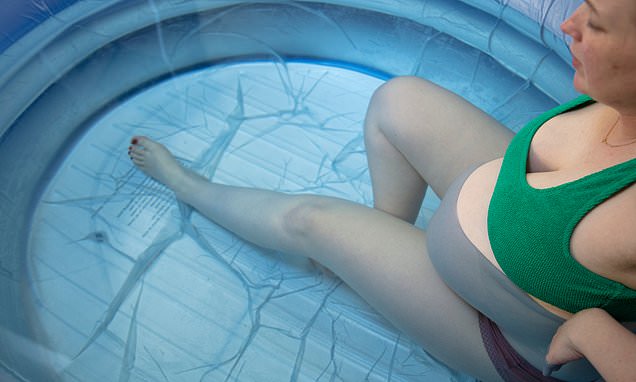Water births provide ‘clear benefits’ for mothers and newborns because they cause less pain and heavy bleeding, study claims
- Birthing pool is used to help with relaxation and pain relief during labour
- Researchers analysed 36 studies involving more than 150,000 women
- Analysis revealed a water birth ‘has clear benefits to women and newborns’
Water births provide ‘clear benefits’ for mothers and their newborns, with fewer complications, evidence suggests.
A water birth involves using a birthing pool to help with relaxation and pain relief during labour.
In some instances the mother exits the pool for the final stages of labour, while others remain in the pool for the birth and bring the newborn to the surface to start breathing.
Researchers analysed 36 studies involving more than 150,000 women to compare the interventions needed during and after labour between the two different types of water birth compared to standard care, without the use of a birthing pool.
Analysis revealed a water birth – regardless of whether the woman gave birth in or out of the pool – ‘has clear benefits to women’.
Compared with standard care, a water birth significantly reduced the use of epidurals or injected opioids, and were linked to less pain and heavy bleeding after the birth.
A water birth also increased mothers’ satisfaction levels and the odds of an intact perineum, however there were more instance of umbilical cord breakage, the scientists said.

A water birth involves using a birthing pool to help with relaxation and pain relief during labour (file image)
The practice was deemed to be as safe as standard care and did not increase the rate of caesarean sections.
Writing in the journal BMJ Open the researchers, from Oxford Brookes University, said: ‘Water immersion provides benefits for the mother and newborn when used in the obstetric setting, making water immersion a low-tech intervention for improving quality and satisfaction with care.
WHAT IS A WATER BIRTH?
A water birth is when a baby is born using a deep bath or birthing pool.
Being in water during labour or birth is relaxing for mothers-to-be and may help with pain – however some pain relief is not offered.
The water can help support the mother’s weight, making it easier to move around and feel more in control during labour. It can help with back pain as well as stretching the vagina as the baby comes out.
Not all births are eligible for a water birth. A baby which is breech or preterm cannot be born in water, or twins or triplets. Mothers cannot have pre-eclampsia, and infection, high temperature or active herpes, for example.
Babies cannot drown when they are born in the water because it comes from the womb – where it survives in fluid – into the water of the pool. Once it is slowly brought up to the surface, it will take its first breathe and cannot be re-submerged.
‘Water immersion is an effective method to reduce pain in labour, without increasing risk.’
They added that doctors should be ‘mindful’ to avoid pulling on the umbilical cord when bringing the newborn to the surface of the water, as this could explain the increased risk of umbilical cord breakage in water birth scenarios.
The authors cautioned that while most of the studies included were conducted in obstetric units, further research is needed to analyse the effects of a water birth in a midwife-led unit or at home.
Commenting on the research Clare Livingstone, professional policy adviser at the Royal College of Midwives, said: ‘This is really good news for women choosing to have a water birth or thinking of having one.
‘There has been previous research outlining the benefits for women and this significant study adds weight to those. It is also positive because it is more information for women when deciding how they want to give birth.
‘Water births are becoming more widely available for women across the UK, but this isn’t the case everywhere. The challenge now is to ensure this choice is open to all women wherever they live.’
Water births started gaining in popularity when the Department of Health recommended them for pain relief in 1993.
They have been on the rise ever since with about 10 per cent of women in the UK giving birth using the method.
But in the US it is not as common. This is because health officials don’t recommend it because of a lack of conclusive evidence of its risks and benefits.
Gwyneth Paltrow, Fearne Cotton and Pamela Anderson reportedly all opted for water births.
Source: Read Full Article
